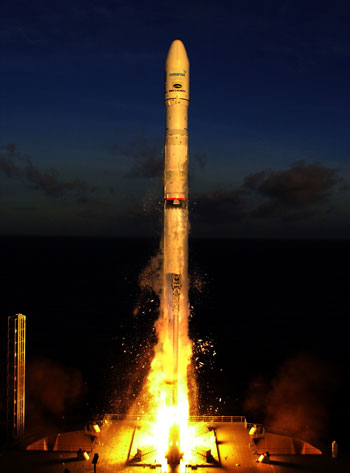Inmarsat broadband satellite hits orbit

The largest ever communications satellite launched by a commercial body was put in orbit on Tuesday. When tests are complete, it will provide broadband connectivity from orbit at a cost comparable to roaming on cellular systems.
The satellite was launched from a converted oil rig in the middle of the Pacific Ocean at 1407 GMT. The I-4 F-2 satellite is the size of a double-decker bus and weighs approximately six tonnes.
It has passed a critical time, according to Inmarsat. "We have 'acquired' the satellite — our ground station in Canada can see the satellite, and control it," said John Warehand, public relations manager for Inmarsat
The satellite is currently moving out of its transfer orbit and into its working geosynchronous orbit. It will sit over the Inmarsat testing station in Italy for two weeks, then deploy the full communications antenna and the 45m-long solar panels. It will cover the Americas, joining one launched earlier this year that will cover Europe, the Middle East and Africa.
Inmarsat will use the satellites for its new service Broadband Global Area Network (B-GAN), which will provide 500Kbps data and telephony standard voice to businesses and other users who may be out of reach of 3G or GPRS services. "The benefit of having both a voice and a data channel is that users can speak and exchange files simultaneously," said Warehand. "The footprint is the size of a continent."
Inmarsat will aim to keep pricing competitive. While no definitive pricing structure has been confirmed Inmarsat said it is "not going to be charging the sort of rates people currently pay in hotel rooms". An existing data-only service, R-B-GAN, costs $6 per megabyte. Inmarsat said end users could "expect something comparable" from B-GAN.
"The media would find this service beneficial. Aid agencies in areas such as Kashmir where the communications structure has been knocked out are already using our services. Governments who need to reach populations with no other infrastructure would also find this service useful," said Warehand.
The satellite modem terminals vary in size from a large paperback book to the size of a laptop, and generally connect to computers via USB. The terminals are manufactured by Nera, Thrana & Thrana, US company Hughes, and Singapore based Addvalue, who have also made Microsoft's Xbox.
B-GAN will be launched before the end of the year in Europe with American coverage coming in early 2006, the company said.

The I-4 F-2 satellite taking off